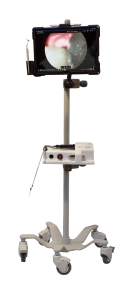Periodontal disease is highly prevalent in America, affecting 50% of those over 30. Traditional treatment methods include blind cleanings in which the dentist or dental hygienist scrapes below the gum-line, unable to see if they have removed all the plaque. If this is unsuccessful, the next step is flap surgery. This painful and costly procedure involves cutting the gums, pulling a flap down and cleaning the teeth, before stitching the flap back in place. The procedure usually involves several days of recovery and opioid prescriptions for pain management. Unsurprisingly many patients don’t go through with it, resulting in 25% of adults over 65 losing all their teeth.
New Advancements
Michael Austin, CEO of PerioEndoscopy, is determined to remove the need for flap surgery all together.

DeVA-1 pictured above
PerioEndoscopy, an Arizona-based company and GlobalMed partner, developed a new method and tool as an alternative to flap surgery: Visual Scaling and Root Planing (Visual SRPSM). This procedure uses a micro-endoscope that fits beneath the gum-line along with the scaling tool so a hygienist can actually see where they are cleaning. The result: no more blind cleanings and no need for flap surgery.
The hygienist performs the procedure with the help of DeVA-1, PerioEndoscopy’s latest dental system. DeVA-1 is a mobile cart that includes a tablet to display the view of the micro-endoscope clearly for the hygienist. The cart is flexible and allows for an ergonometric workflow; the tablet can be moved and positioned any way the hygienist wants.
Austin believes this system can change the way dentistry is done and even eliminate the need for flap surgery. Patients can enjoy better dental health without a long and painful recovery period. Because patients could immediately return to work, the procedure could be especially useful for the military’s active duty members, who would no longer be out of commission during recovery.
Beyond Visual SRP, the DeVA-1 and micro-endoscope have secondary uses, particularly for implants. Many dental patients turn to implants to avoid the possibility of dentures down the line. Yet dentists often can’t see underneath the implant to make sure there is no glue line, which can be a magnet for bacteria due to its porous qualities. In fact, almost 60% of implant failures are due to a glue line infection. DeVA-1 can solve this problem by allowing the dentist to see any glue lines under the implants and remove them prior to any infections.
Our goal is to cause Visual SRP and its equipment to be as ubiquitous a drill in every dentist office, stated Austin.
Telemedicine and Dentistry
To better serve the dental field, PerioEndoscopy has partnered with GlobalMed to incorporate our eNcounter software within the DeVA-1 so a hygienist can connect with a remote dentist or periodontist during a procedure. The dentist can see what the hygienist is seeing with the micro-endoscope and offer consultation advice in real time. This is especially beneficial to hygienists serving rural communities without specialists; the hygienist can use GlobalMed’s eNcounter software and the DeVA-1 to consult with a dentist immediately.
Telemedicine is on the rise in dentistry, and these new advancements are another way to improve care and promote a more collaborative environment.

This is a great new advancement in oral care that will help improvements in systemic health.
That is cool they have a nice machine for a procedure. It would be nice to get rid of the periodontal disease. Maybe this machine could help in treatment.
I had no idea that periodontal disease affects 50% of Americans over the age of 30. That’s scary to know. I want to make sure I do what I can to prevent this or to know what treatment options there are.